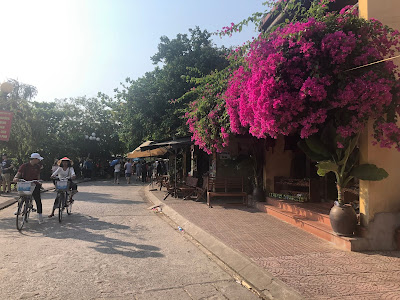Hoi An 會安
Hoi An is a city located at the middle of Vietnam. The focal point of interest is the old Hoi An, the city's historical centre. Hoi An flourished and became an important trading port between 15th and 19th century. However, its importance waned sharply by the end of 18th century. The new emperor Gia Long repaid the French's aids by giving them exclusive trade rights to the nearby port town of Da Nang. Da Nang emerged and Hoi An became forgotten. Not until 200 years have elapsed, Kazimierz Kwiatkowski (Polish architect) brought Hoi An back to light. Being a well preserved example of a Southeast Asian trading port and with buildings displaying a blend of local and foreign influences, Hoi An old town was declared a World Heritage Site by UNESCO.
Our hotel (Pearl River Hoi An Hotel) is located 1.2km away from the old town centre. We walked leisurely along the river. The silence was broken once we have left the river. Lively scenes pop up. Around the corner is a jewelry shop. We exchanged our money there. Soon we reached the market, both open and covered. Hawkers always wanted to sell you something. I remember we were chased by a woman selling shoes.
The best way to enjoy Hoi An is to walk along the river, appreciate the well preserved / renovated houses, boats, lanterns and people.
One won't miss the Japanese Covered Bridge in Hoi An as it is one of the most touristic areas. The beautiful Japanese architecture is dated back to 17th century. It was created by a Japanese living in Hoi An for connecting to the Chinese quarter across the water. Roughly 40 years after the Hoi An Japanese Covered Bridge was constructed, the Tokugawa Shogunate demanded that its overseas citizens to go home.
 |
| Hoinan Assembly Hall |
 |
| Hoinan Assembly Hall Interior |
Not far away stands the House of Tuy Tien Duong (明鄉萃先堂). was established in the late 18th century. It mainly worships the ancestors of the Minh Huong people instead of the gods. Minh Huong people refer to Chinese ethnic groups who left China to Vietnam from the end of the Ming Dynastry in the 16th and 18th centuries.
Closer to the centre is another one, Guangzhou Shaoxing Assembly Hall (廣肇會館). It has a beautiful facade. The couplets has two sentences. Each begins with the character Guang 廣and Shao which represent Guangzhou and Shaoxing 肇. Hoi An is very touristic. Entrance fee is required at the assembly houses we passed by. We did not pay to go inside because we have seen Chinese architecture in Beijing.
The sunset and night scenes in Hoi An are gorgeous. Be sure to enjoy the sunset and then linger around to choose a venue for dinner. After your meal, do take some walks to enjoy the night with thousands of lantern. If you are not full, you can still have snacks and desserts at the night market.























Comments